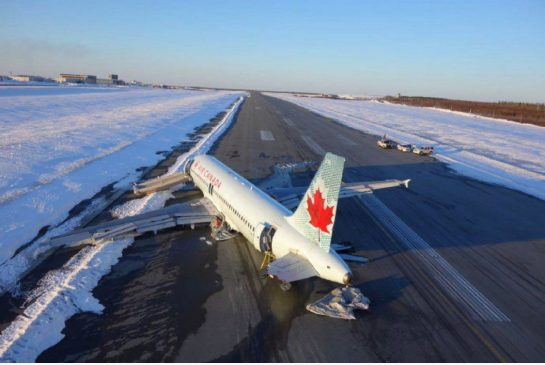HALIFAX – An Air Canada jet that crashed about 200 metres short of a runway at the Halifax airport during a March snowstorm had no major mechanical problems, the Transportation Safety Board says in a preliminary report released Tuesday.
Of the 133 passengers and five crew members aboard the flight from Toronto, 25 were injured.
The independent board’s update says the Airbus 320-200 was correctly configured for landing, its air speed was consistent with a normal approach and there were no mechanical deficiencies with its engines, flight controls, landing gear and navigation systems.
Lead investigator Doug McEwen said the investigation has not been completed, but his team has already taken a close look at the plane’s engines, airframe and its components.
The board’s update also confirmed that the weather at the time of the crash was poor.
At 12:15 a.m. on March 29, the wind was gusting at 48 kilometres per hour from the north-northwest and forward visibility was 800 metres amid snow and drifting snow, the statement says. The plane hit the ground at 12:43 a.m.
As well, the board says vertical visibility above the ground was just 91 metres.
Passengers have said the plane circled the airport for a half hour because the pilot said he was waiting for better visibility.
Shortly after the crash, Air Canada Chief Operating Officer Klaus Goersch said the weather was appropriate for landing.
In an emailed statement, an Air Canada spokesman said the airline wouldn’t comment on an interim report.
The jet’s flight-data recorder and cockpit voice recorder have been examined, but the board says it has yet to look into pilot training, experience and “human performance aspects.”
McEwen said human performance refers to how members of the flight crew responded to one another in the cockpit and how they interacted with the cabin crew.
The board’s ongoing investigation will include producing an animation of the flight profile and reviewing cabin crashworthiness and the passenger evacuation procedures, among other things.
The board’s update contains only factual information and no analysis, which will be included in a final report, McEwen said.
During its final approach to Halifax Stanfield International Airport, the aircraft was being guided to Runway 05 by a so-called localizer approach procedure. This procedure provides pilots with only lateral guidance to align the aircraft with the runway, the board said.
“It’s a non-precision approach that is used at many airports across Canada,” McEwen said.
“Part of the investigation will be looking at … the type of approach procedure in place there, as well as the regulations that Transport Canada has for them, as well as what the airport and Nav Canada have in place.”
As Flight 624 neared the runway at low altitude, its engines severed overhead power lines, cutting power to the airport terminal, and the jet’s main landing gear and rear fuselage hit the snow-covered ground about 225 metres before the runway threshold.
The aircraft then struck a localizer antenna and hit the ground in a “nose-down attitude” about 70 metres before the runway threshold.
“It then bounced and slid along the runway, coming to rest on the left side of the runway about 570 metres beyond the threshold,” the report says.
The board initially said the plane hit the ground for the first time 335 metres short of the runway and slid another 335 metres, but McEwen said the investigation yielded more precise figures.
Though the airliner was badly damaged and one of its engines was sheared off, there was no fire.
A subsequent examination of the fuselage showed the cabin floor had been punctured from below in two places.
Some passengers said they waited for more than an hour for emergency responders as they stood outside in temperature hovering around -6 C.
The airport has said passengers waited up to 50 minutes for help and that firefighters were on scene within 90 seconds.
